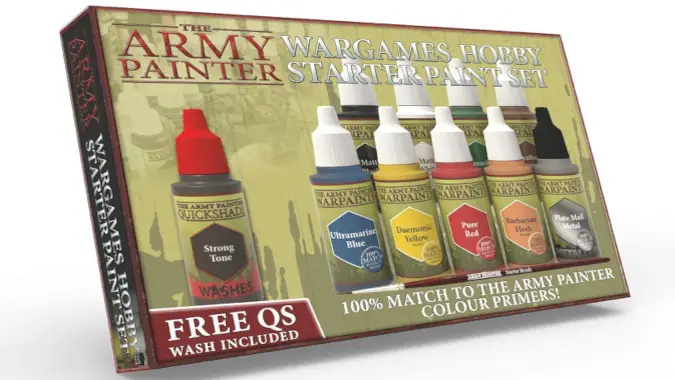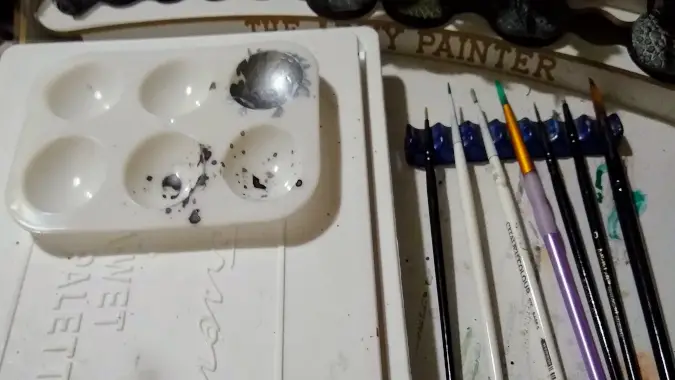Getting started with painting D&D miniatures

With the rise in popularity of Dungeons and Dragons, there has been a substantial increase in people that are interested in immortalizing their characters in miniature form. If you’ve listened to our podcasts at all, you’ll likely know that miniature painting is a huge hobby of mine. I’ve been doing it for almost 30 years and it tends to be a large part of my daily routine. As a result, I often get asked what seems like a simple question, but can be very daunting for newcomers — how do I get started with painting miniatures?
Creating your own miniature involves sourcing the figurine, painting the it, and making sure it fits your mental image of the character. There are many ways to go about this, with different techniques and options — in fact, we’re spoiled for choice — so keep in mind that this just represents my opinion, things that I’ve found useful for others that I’ve helped to take the first steps into miniature painting. I hope these tips and pointers for painting your own minis will help get you started, but if any of my advice isn’t helpful, don’t be afraid to deviate.

How to select a miniature
Selecting your miniature is both an exciting and potentially overwhelming endeavor. There are a plethora of choices from big names like Games Workshop and Reaper Miniatures, or you can even customize your own on sites like Eldritch Foundry and Hero Forge — there’s something for everyone. I recommend to keep it simple, and keep it cost effective, especially when you’re just starting out. I mostly recommend sticking to miniatures from Wizkids! and their various unpainted miniature lines at first. These consist of Dungeons and Dragons-specific miniatures from the Nolzur’s Marvelous Miniatures line, or Pathfinder Battles Deep Cuts, and even the Critical Role miniatures. You can also find minis in their line for Transformers and My Little Pony.
There are several reasons I recommend Wizkids! as a good starting point. The first thing I would point out is the cost. A basic adventurers model is a suggested retail price of $4.99 USD for not just one, but two miniatures — normally both a male and female variety of whatever miniature you’re working with, or a lower level and higher level version of the same character. Larger single models start at the same price point and you can get full blown monsters for relatively cheap compared to others on the market. The second thing is that these models are all pre-primed. Normally, when you have a miniature you need to put a base layer of paint down, or primer, for the paint to better adhere to the figure. This can be finicky and even dependent on the weather, so a model that is already pre-primed for you not only allows you to skip a step without buying any extra materials, but also you don’t have to worry about getting this step right. You can focus on getting your colors on the model and diving right in.
Third, there is a staggering variety of miniatures available in this line. There are classics like Elf Fighters and Clerics, to Vampires and Werewolves, and everything in between, so it’s highly likely you’ll find something you want to paint. The last point is that these models are widely available pretty much everywhere — almost every local gaming store, comic shop, and even toy store, is likely to have these available. If they don’t, or you don’t have a local brick-and-mortar retailer near you, they’re also available online through a lot of retailers, even directly from Wizkids! themselves.
These reasons combined make Wizkids! my go-to miniatures when someone asks, but I should stress that there’s no real wrong choice for your miniature base, as long as you make sure it’s something you think looks cool and that you want to paint. Honestly, the cooler you think it is, the more likely you are to actually sit down and start painting.

Paints and brushes for beginners
This is another area that has a large number of options available to us. The two most common choices are Games Workshop and The Army Painter which are both widely available online and at local retailers across the world. Of the two, I normally recommend Army Painter for you to start.
Price wise, Army Painter paints wind up in the same category as the Wizkids! miniatures. They’re very affordable, coming in usually around $3 USD per bottle, and are made with miniature painting specifically in mind. Their brushes tend to also be very reasonably priced, ranging from between $5 and $10 USD, and because they are synthetic they are able to take quite a beating before they’re no longer usable, which makes them great for beginners. Some specialty paints and brushes for miniatures can cost three times this amount and have variable quality, but Army Painter has made it a mission to provide a wide variety of affordable paints for beginners and seasoned veterans alike.
The color selection they provide is quite extensive, and even has things like technical paints available to you such as washes and inks. They do, however, do something I haven’t seen a lot of companies do in recent years — they put together sets of paints, and specifically have one geared towards beginners. The Warpaints Starter Paint set comes with 10 paints, including a wash and a metallic silver, covering all your basic color needs in a tidy package. It also comes packaged with a starter brush for you to get started without having to make yet another decision. They also include in each package a getting started pamphlet, with the basics on how to use their paints, as well as links to actual tutorials and guides in both PDF and video format on their website. The starter set can usually be found for about $35 USD, and for 10 paints and a brush, that’s a crazy amount of value to help get you started.
Don’t forget to grab these extras before you start
After that all that’s left is a few extra pieces of equipment that I recommend you make a part of your kit before you get started.
You’re going to need some form of water cup to clean your brush between colors and when you’re done. This doesn’t have to be fancy and can be a plastic cup, just something to keep water in. Similarly, you’re going to want some paper towels as well, for cleaning up and for wiping off your brushes after you rinse them with water.
The last thing you’ll need is something to put your paint on while you’re using it. You can get yourself a paint palette, but honestly you don’t even need one — a wax-coated paper plate works just fine. It’s cheap, and you likely have some on hand already. They work insanely well when you’re first starting out. I still use them for painting classes because of this. If you really want to get something re-usable, the dollar store is a great source of very cheap painting supplies. I wouldn’t recommend getting your paint there, but they stock things like cheap plastic palettes, cups, plates, and even some cheap brushes can be worth your time to grab. Just bear in mind that brushes from the dollar store will not last very long, but plastic goods are pretty handy.

Bringing it all together
Now that you have your models, paints, and brushes, it’s time to sit down and dive in. At this point I would recommend checking out the tutorials on the Army Painter’s website. Unlike trying to wade through the sea of videos on YouTube or articles online, these are very beginner focused and offer both written and video advice that supports each other. They are fantastic starting points. They’ll show you how to get the paint out of the bottle, basic techniques for applying the colors and washes, as well as how to mix paints to make them lighter or darker to get the most out of your starting set. Not that there aren’t great tutorials elsewhere, or fantastic lessons available online, these just happen to be highly accessible, curated, and specifically targeted at people just starting in the hobby.
There is one last piece of advice I give everyone just starting — painting is a skill that has to be learned over time. No one picks up a brush and is immediately Da Vinci. It will take time, practice, and repetition. I actually keep the first model I ever painted on my desk to remind me of that. Try not to hold yourself to any standards that you see online, which is something I hear a lot from beginners. There’s no wrong way to paint your miniature, as long as you are happy with the work you’ve done on it.
Originally posted 2/3/2022. Updated 2/9/2022.
Please consider supporting our Patreon!
Join the Discussion
Blizzard Watch is a safe space for all readers. By leaving comments on this site you agree to follow our commenting and community guidelines.






